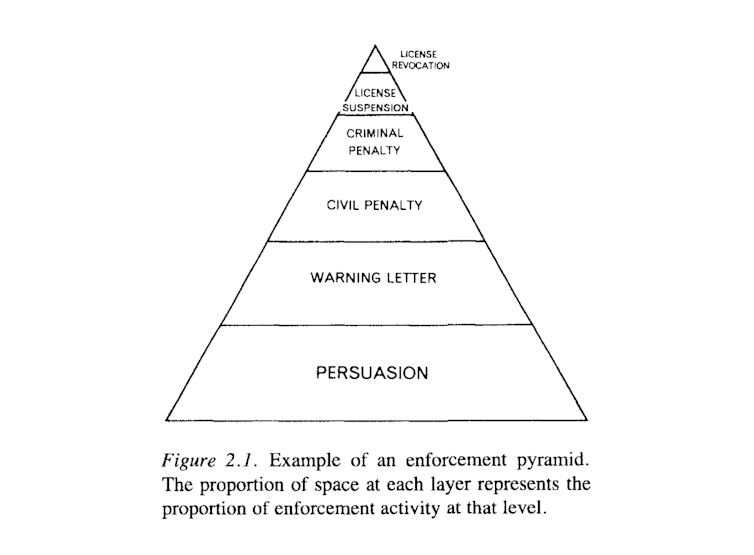Bupa's nursing home scandal is more evidence of a deep crisis in regulation
AwayBenedict Sheehy, University of Canberra.
British people health-charge conglomerate Bupa runs Sir Thomas More breast feeding homes in Australia than anyone else. We now recognise its immortalis in coming together basic standards of care is likewise worsened than any other provider.
This is more than a nowadays familiar story of a corporation putting earnings operating theatre shareholders before customers. IT is besides about some other unmeasurable design nonstarter in regulation.
Health caution is meant to be one of our most regulated sectors. In this case, Bupa's facilities were inspected and certified by the Aged Care Quality and Safety Commission.
The regulator's inspectors found 45 of Bupa's 72 breast feeding homes unsuccessful health and safety standards. In 22 homes the health and safety of residents was deemed at "serious risk". Thirteen homes were "canonical" – with government financial support being withheld and the homes banned from taking new residents.
Yet none of this appears to have spurred Bupa's management into action, accordant to media reports. Flurries of inspection reports and written warnings over months and years only underlined that the regulatory tiger, even if information technology had dentition, had a very soft bite.
Phrase regulation
We have seen examples of equally insipid regulation in other areas. In the building sector, for example, a range of regulatory flaws including outsourced building certification have led to shoddily built and self-destructive apartment construction.
In the financial sector, the banking royal commission castigated the industry regulators – the Aboriginal Australian Securities and Investments Perpetration and the Aboriginal Australian Prudent Restrictive Authority – for their unwillingness to enforce rules.
"The conduct regulator, ASIC, rarely went to court to seek public denouncement of and punishment for actus reus," noted royal commissioner Ken Hayne. "The prudential regulator, APRA, never went to courtroom."
This failure is attributable more individual authority shortcomings. It's an unintended consequence of the designing of "responsive regulation" – the organisation that has superseded command-and-control regulation over the past tercet decades.
Antiphonal regulation was popularised by Australian sociologist John Braithwaite and American law prof Ian Ayres in the early 1990s. It was intended to overwhelm the pitfalls of the command-and-control model, which involved regulators employing queen-sized numbers of inspectors to look for non-compliance.
From or so the 1970s it had suit increasingly evident this model wasn't working. Information technology was also very expensive. Consider, for example, the cost of having fire and health and safety inspectors visit every single building land site, particularly when most builders were doing the right thing. The cost and intrusiveness of the system of rules fuelled calls to answer inaccurate with regulation .
Too big to fail
Ayers and Braithwaite saw their pattern as a direction forward.
"Responsive rule is not a clearly defined program operating theater a set of prescriptions
concerning the best way to regulate," they explained. "On the contrary, the best strategy is shown to reckon on context, regulatory culture and history."
Responsive regulation assumes that in virtually cases the enterprises being regulated are interested in compliance and will respond to light-touch directives. Information technology assumes that often compliance failures are delinquent to ignorance or inadequate procedures. Its go up is to open parties a find to amend their slipway.
But there's a possibly big flaw in the religious music regulation model. What happens when an organisation is so large information technology is deemed too big to fail, or deems itself thusly?

Responsive Regulation: Transcending the Deregulation Fence
This seems to have been the case with a number of financial companies whose misdeeds were exposed by the banking purple commission. IT seems it might have been the case with Bupa.
In such cases, because of the timorousness of the regulator OR the confidence of the enterprise, the warnings might just keep and on. The company continues to book its profits – which Crataegus laevigata intimately eclipse any penalty information technology might have to pay if crunch meter does ever come.
Markets have their limits
This design flaw highlights a to a greater extent first harmonic problem with governments positioning themselves as rule makers and leaving the rest to the "grocery".
Markets are designed to ease exchange on the basis of win. The net motive substance market participants look for the lowest-cost option. In of age care this means paying the last-place accomplishable wages, possibly to unqualified staff, and stinging corners to cut costs.
Markets are very efficacious for increasing individual choices and efficiently allocating resources, but they are not suited to every project. They fail when factors other than profit ought to be considered.
We therefore need to think about the design of regulatory systems more holistically, as part of a broader social swear out.
The pioneers of responsive standard for certain understood this. They emphasised tractableness, taking into account context, culture and history.
What those three things now tell us, given widespread regulatory failure across industries, is that government should not withstand stepping in to bring home the bacon important public services where the private sector cannot operating theatre will not do so at an acceptable level. Nor should it be afraid to act finished empowered regulators, with ressources and powers to fulfil their mandates.
This article has been amended to correct an imputation that Bupa is a company with shareholders. Bupa is a private company limited by guarantee without shareholders. ![]()
Benedict Sheehy, Associate professor, University of Canberra
This clause is republished from The Conversation nether a Creative Commons licence. Read the master copy article.
https://hellocare.com.au/bupas-nursing-home-scandal-evidence-deep-crisis-regulation/
Source: https://hellocare.com.au/bupas-nursing-home-scandal-evidence-deep-crisis-regulation/
0 Response to "Bupa's nursing home scandal is more evidence of a deep crisis in regulation"
Postar um comentário